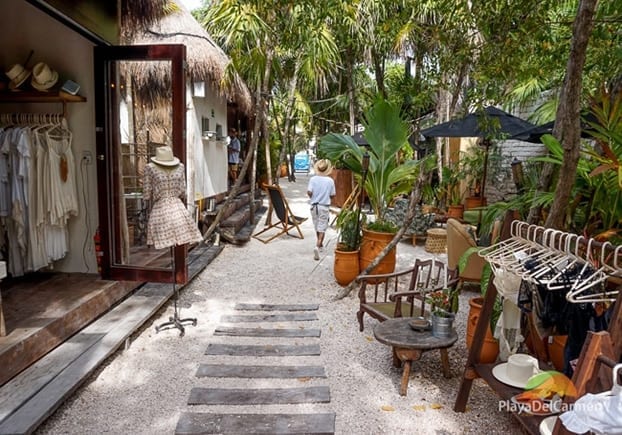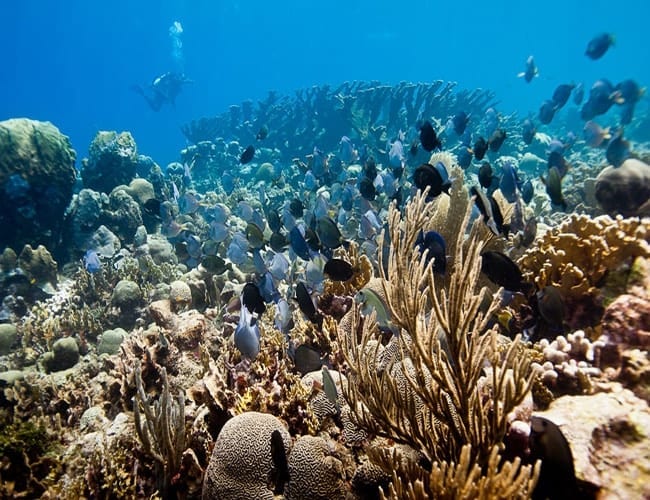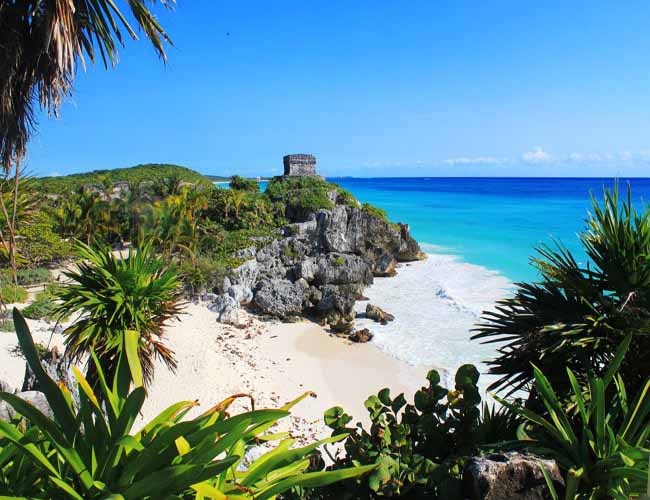Twenty years ago, very few people had heard of the Riviera Maya. All it was was a few isolated fishing villages and rural Indian villages along a spectacular, unspoiled coastline.
Today, the ever-busy Highway 307, a two-lane highway in each direction, connects a growing number of tourist towns. There are signs all the way as one passes exits to resorts, golf courses, condo developments, ecological centers, and archaeological ruins, one after another! Even Cirque de Soleil has its own property along the highway, hosting the Mexican Cirque group as well as a concert center for performances. The road is always busy with a preponderance of tourist buses and vans traveling between the sights in this now-bustling region.

Highway 307 was originally known as the Cancun – Tulum Corridor. Officially, Cancun is not on the Riviera Maya, although it now blends into it due to the the tourist development of the coastline straddling the Caribbean Sea. This ongoing development does not stop for the entire length of the 81 mile corridor that extends from Cancun to just south of Tulum. And thus, while officially the Riviera Maya runs between Playa del Carmen to just South of Tulum, conversationally it now includes the entire coastline. In 1995 the Riviera Maya had 1470 hotel rooms – today there are more like 35,000 and growing. With this sort of development, it is the fastest-growing tourist destination in Latin America.
The coastline is not visible from Highway 307, despite its proximity. The road is separated from the water by a strip of land composed of wild jungles with tropical animals, birdlife and an underground river system that creates caves, caverns and cenotes, which are sinkholes, some large and some small, in which people can swim.

PLAYA DEL CARMEN
Playa del Carmen, a small fishing village until a few years ago, is midway between Cancun and Tulum and is the fastest growing city in Latin America with a 26% annual growth rate. Arriving in Playa del Carmen, you can feel the energy that has transformed this former fishing village into a hip and happening town with roadworks and ongoing building development.
Although it is rustic and “au naturel”, “Playa” (as it is known colloquially) has a sophistication and is more European than any other Mexican resort. It is one of the top diving destinations in the world, with extraordinary underwater marine life and caves along the Great Mayan Reef. It also has miles of pristine beaches with clean white powdery sand and translucent undulating waters in varying shades of torquiose and aquamarine depending on the tides and time of day.

Playa has attracted some prestigious hospitality groups, such as Rosewood, Mandarin, Thompson and Grand Hyatt, the last having recently opened a sophisticated resort that extends from the Pedestrian Street to the oceanfront, showing off the spectacular architecture and killer views. In addition, there was an influx of developers who built condos that further transformed this sleepy little fishing village into a thriving coastal resort.
The atmosphere is more European than most Mexican tourist towns and has a rustic charm because of its inclusive tropical vegetation that has been carefully preserved as an important design feature. Having survived one real estate bubble due to overpricing, over development and worldwide conditions, Playa recovered from the downturn and prices have again appreciated. It is well on its way to becoming an interesting tourist town to include a growing population of permanent residents.

The main thoroughfare is Fifth Avenue (Avenida la Quinta), a” pedestrian only” street one block up from the beach that is loaded with hotels, shops and restaurants. Even though Fifth Avenue is in the center of town, great care has been taken to keep the indigenous vegetation that was originally on it, and restaurant tables are set among tall trees with trailing vines … and the occasional cenote (sinkholes are part of the ecosystem, after all). Fifth Avenue is funfilled, but with lots of rustic charm and enough distractions to attract visitors at all times of the day and night. It illustrates how Playa has grown up: the city boasts a symphony orchestra, a planetarium, art galleries and international music and film festivals throughout the year.
TULUM
Ah, Tulum !! Until a few years ago Tulum was barely on the map. Then, like so many other of these cities, it was “discovered” by backpackers who are at the forefront of finding unique and beautiful places off the beaten path (and then telling developers about them). By word of mouth, they passed along the virtues of this unique and magnificent paradise, with its miles of pristine beaches and crystal clear aquamarine waters and it is now mainstream and an internationally famous hotspot. Small hotels were built to cater to those coming in search of good health, spiritual and yoga retreats and there has been an influx of new restaurants, bars, and coffee shops. But even with these changes, it remains jungle shrouded and eco-friendly with an emphasis on wellness.


In Tulum, Highway 307, passes through the center of town where it becomes a main thoroughfare for a few — very much like any other beach town, with clothing and souvenir shops, mini markets interspersed with small restaurants and ice cream shops.

But taking Avenida Coba off Freeway 307, where it becomes Beach Road, there is a distinct change in character. The road is lined with small hotels specializing in ecotourism, spiritual and yoga retreats, and in spite of the development around them they have been able to preserve the New Age vibe and natural habitat. Importance is placed on the outdoors. Some hotels provide semi-outdoor bedrooms with floors, ceilings and moveable walls! This is similar to “glamping” but priced comparably to accommodation in any major city hotel in the world that has built-in AC and proper walls !! There are strict rules about architecture, development and preservation of the natural habitat in the area which makes the locale a unique enclave, one that has deliberately sidestepped rampant commercialism.
Most of the hotels are concealed behind dense vegetation and fences made from grasses and timber. There is always a guard at the gate to protect the privacy of the guests and no street lighting is allowed at night. As a result of these considerations for the environment, Tulum is is now frequented by international celebrities and one can read about it in every magazine both high and lowbrow, social, health, travel and fashion – it checks all the boxes. This is no longer the backpackers-exclusive heavenly beach paradise. Even though it is laid back, it has joined the ranks of places to see and be seen.

THE GREAT MAYAN REEF
The Great Mayan Reef, also known as the Mesoamerican Barrier Reef, is another of the attractions to this area, perhaps the most magnificent. It is a complex ecosystem and the second largest barrier reef in the world, stretching 600 miles while ringing five countries including Mexico.
Here, it follows the Caribbean Coast from Cancun through the length of the Riviera Maya and is known for its multitude of dazzling coral colonies in exquisite colors, most of which have been ten thousand years in the making. In addition to the sixty-five species of stony coral and five hundred species of fish, there are mollusks and crustaceans, loggerhead and green turtles, and the elegant queen conch. Fortunately, the marine life in this reef system is healthy and relatively unharmed by pollution or the earth’s warming. It complements the shoreline ecosystem which boasts the longest underground river system in the world and, of course, cenotes. Some cents even have some with caves and stalagmites and stalactites.
One of the annual natural underwater “events” that take place from May to September is the migration of the whale sharks, the largest of the fish species. They come from colder climates to the warmer waters of the Caribbean Sea off the River Maya Coast to feed and mate.
Tags on the sharks, put there by marine biologists, indicate that some of them have swum as far as five thousand miles to reach the Great Mayan Reef System, much like some tourists. It is estimated there are about eight hundred of these bus-sized, forty-foot-long “fish” that migrate each season to feed off plankton and small fish from the reef. Quite a lot of traffic !!
There are more males than females present and it is suspected the pregnant females swim off somewhere else to “pup” or give birth. Part of the mystery surrounding the whale sharks is how they mate and give birth, as no amount of scientific invasiveness has succeeded in finding out these intimate details. Some things are better left unknown?
The Mexican Government is aware of how precious and valuable the Mesoamerican Reef System is and why it attracts snorkeling and scuba divers to the area from all over the world, making it a prime tourist destination. It’s happily in their interest to ensure its continued protection.

